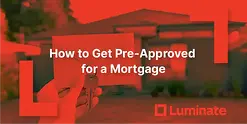Not Mortgage Ready? Action Plan for NZ First-Home Buyers
 By
Trent Bradley
·
17 minute read
By
Trent Bradley
·
17 minute read

You've been thinking about buying your first home. You've probably browsed a few listings, checked a mortgage calculator, and maybe even spoken to a broker. But what happens if you realize you're not quite ready?
Table of Contents
- Why Being "Not Ready" Is Actually Good News
- The 5 Most Common Reasons You're Not Mortgage Ready
- Step 1: Get a Professional Mortgage Readiness Assessment
- Step 2: Build a Savings Plan That Actually Works
- Step 3: Eliminate and Manage Debt Strategically
- Step 4: Fix Your Bank Account Conduct
- Step 5: Repair Your Credit History
- Step 6: Improve Your Income Position
- Step 7: Create Your Personalized Timeline and Action Plan
- How Luminate Supports Your Journey to Mortgage Ready
- Frequently Asked Questions About Getting Mortgage Ready
- Take the First Step Today: From Not Ready to Mortgage Approved
Key Takeaways
- Being "not mortgage ready" is just a starting point—with focused action, most first-home buyers can qualify within 6-12 months.
- The five main barriers are: insufficient deposit, unstable income, excessive debt, poor banking conduct, and credit history issues.
- Pay off high-interest debt (especially credit cards) before maximizing deposit savings—debt impacts borrowing capacity more than extra deposit helps.
- Three months of clean banking (no overdrafts, bounced payments, or gambling) can dramatically improve your application.
- Close all Buy Now Pay Later accounts at least 6 months before applying—even zero-balance accounts are red flags to lenders.
- The 50/30/20 budget rule (or aggressive 50/20/30 variation) provides a proven framework for building your deposit while managing living costs.
- Free professional mortgage readiness assessments provide clarity on exactly where you stand and create actionable month-by-month plans.
Whether it's your deposit, income, debts, or credit score holding you back, the good news is you're not alone—and there's plenty you can do to get on track.
At Luminate Financial Group, we help people every day who are just starting out. Some need a few weeks to tidy up their accounts. Others need a longer-term strategy. Either way, being not mortgage ready is just a starting point, not a dead end.
This comprehensive guide will walk you through exactly what to do if you're not quite there yet and how to turn that into a clear, actionable plan toward buying your first home in New Zealand.
Why Being "Not Ready" Is Actually Good News
Discovering you're not mortgage ready before you start making offers is actually a positive outcome. Here's why:
The Benefits of Early Assessment
Avoid disappointment: Finding out after making an offer that you can't get approved is devastating and can cost you your deposit
Save time: Focus your property search only when you're genuinely ready to buy
Improve your position: Use the time to strengthen your application and potentially borrow more or get better rates
Reduce stress: Remove the pressure of urgency while you build a solid foundation
Learn the process: Understand exactly what lenders look for and how to position yourself strongly
Many of our most successful first-home buyers came to us initially "not ready." Within 3-12 months, they'd addressed the key issues and secured mortgage approval with better terms than they initially expected.
The 5 Most Common Reasons You're Not Mortgage Ready
Understanding exactly what's holding you back is the first step to fixing it. For most first-home buyers in New Zealand, there are five main barriers to mortgage approval.
Reason 1: Insufficient Deposit
The issue: You don't have enough savings for a deposit that meets lender requirements.
What lenders want:
- Minimum 10% deposit for most standard loans
- 20% deposit for best rates and to avoid Low Equity Premium (LEP)
- 5% deposit if you qualify for First Home Loan scheme
Why it matters: Your deposit size affects:
- Whether you can borrow at all
- The interest rate you'll be offered
- Additional fees and charges
- Total borrowing capacity
Typical timeline to fix: 6-24 months depending on savings rate
Reason 2: Income Too Low or Unstable
The issue: Your income isn't sufficient to service the loan you need, or your employment situation is too unstable.
What lenders assess:
- Total household income
- Employment type (permanent, contract, casual, self-employed)
- Length of time in current role
- Income stability and consistency
- Future income prospects
Common income issues:
- Recently started new job (less than 3-6 months)
- Casual or contract work without long history
- Self-employed with less than 2 years trading
- Variable or commission-based income
- Frequent job changes
Typical timeline to fix: 3-18 months depending on the specific issue
Reason 3: Excessive Debt Levels
The issue: Your existing debts reduce your borrowing capacity or make you appear high-risk.
Debts that impact mortgage applications:
| Debt Type | Impact Level | Why It Matters |
|---|---|---|
| Credit cards | High | Lenders assess based on limit, not balance |
| Personal loans | High | Fixed monthly commitment reduces serviceability |
| Car loans | Medium-High | Significant monthly payment |
| Student loans | Medium | 12% of income goes to repayment |
| Buy Now Pay Later | Medium | Indicates short-term spending habits |
| Overdrafts | High | Suggests poor cash flow management |
| Outstanding bills | Very High | Red flag for financial management |
Typical timeline to fix: 3-18 months depending on debt levels
Reason 4: Poor Bank Account Conduct
The issue: Your day-to-day banking behavior raises concerns about financial management.
Red flags lenders look for:
- Frequent overdrafts or dishonor fees
- Bounced payments or direct debits
- Regular gambling transactions
- Unexplained large cash withdrawals
- Minimal or no savings pattern
- Living paycheck to paycheck with no buffer
- Mixed personal and business expenses (if self-employed)
What lenders want to see:
- Consistent bill payments
- Regular savings deposits
- Account always in credit
- Financial buffer maintained
- Organized money management
Typical timeline to fix: 3-6 months of clean banking history
Reason 5: Credit History Issues
The issue: Your credit report contains defaults, missed payments, or other negative information.
Common credit problems:
- Defaults on loans, credit cards, or utilities
- Missed or late payments
- Multiple credit applications in short time
- Bankruptcy or debt repayment orders
- Court judgments
- Too many active credit accounts
Typical timeline to fix: 6-24 months depending on severity and how long ago issues occurred
Step 1: Get a Professional Mortgage Readiness Assessment
Before you can fix the problems, you need to understand exactly where you stand. A professional mortgage readiness assessment provides clarity and direction.
What a Mortgage Readiness Assessment Includes
At Luminate, our free assessment covers:
| Assessment Area | What We Review |
|---|---|
| Deposit position | Current savings, KiwiSaver balance, potential First Home Grant eligibility |
| Income analysis | Employment type, stability, sufficiency for target property price |
| Debt assessment | All existing debts and their impact on borrowing capacity |
| Banking conduct | Review of recent bank statements for lender acceptability |
| Credit history | Credit report review and identification of any issues |
| Borrowing capacity | Realistic calculation of current and potential future borrowing |
| Timeline projection | How long until you're mortgage ready based on current trajectory |
| Action plan | Specific steps to take in order of priority |
What to Bring to Your Assessment
Essential documents:
- Last 3 months bank statements (all accounts)
- Recent payslips or proof of income
- KiwiSaver statement
- List of all debts and monthly payments
- Copy of credit report (if you've obtained one)
- Rough idea of target property price
The assessment process:
- Initial consultation (30-45 minutes) - Discuss your situation and goals
- Document review (1-2 days) - Adviser analyzes your financial position
- Feedback session (30 minutes) - Clear explanation of findings
- Action plan creation - Written roadmap with specific milestones
- Ongoing support - Regular check-ins as you work through the plan
Understanding Your Readiness Score
After assessment, you'll fall into one of these categories:
Mortgage Ready Now (Score: 8-10/10)
- Can apply immediately with good chance of approval
- May need minor documentation gathering only
Nearly Ready (Score: 6-7/10)
- 1-3 months away from being ready
- Usually 1-2 specific issues to address
- Can start property research
On Track (Score: 4-5/10)
- 3-6 months of focused work needed
- Several issues to address
- Should start building savings discipline
Foundation Building (Score: 2-3/10)
- 6-12 months minimum timeline
- Multiple issues requiring attention
- Need structured savings and debt plan
Early Stage (Score: 0-1/10)
- 12-24+ months realistic timeline
- Significant work required across multiple areas
- Need comprehensive financial restructuring
The good news: We've helped clients move from a 2/10 to mortgage approved in 8-12 months with focused effort.
Step 2: Build a Savings Plan That Actually Works
One of the biggest challenges for first-home buyers is building sufficient deposit savings while managing everyday living costs.
Setting Realistic Savings Targets
Calculate your deposit goal:
| Purchase Price | 10% Deposit | 20% Deposit | Additional Costs | Total Needed (10%) | Total Needed (20%) |
|---|---|---|---|---|---|
| $500,000 | $50,000 | $100,000 | $5,000 | $55,000 | $105,000 |
| $600,000 | $60,000 | $120,000 | $6,000 | $66,000 | $126,000 |
| $700,000 | $70,000 | $140,000 | $7,000 | $77,000 | $147,000 |
| $800,000 | $80,000 | $160,000 | $8,000 | $88,000 | $168,000 |
Timeline examples:
If you can save $500/month:
- Reach $30,000 in 5 years
- Reach $60,000 in 10 years
If you can save $1,000/month:
- Reach $30,000 in 2.5 years
- Reach $60,000 in 5 years
If you can save $2,000/month:
- Reach $60,000 in 2.5 years
- Reach $120,000 in 5 years
Plus KiwiSaver contributions and investment returns
Creating "Genuine Savings"
Banks want to see "genuine savings"—money you've saved yourself over time, not gifts or windfalls.
What counts as genuine savings:
- Regular deposits to savings account over 3+ months
- KiwiSaver contributions
- Term deposits
- Managed funds or investment accounts
- Consistent saving pattern
What doesn't count (or is viewed skeptically):
- Recent large lump sum deposits from unknown sources
- Money just moved from another account
- Recent gifts (though these can help, they don't show saving discipline)
- Gambling or competition winnings
- Cash savings with no paper trail
The 50/30/20 Budget Rule Adapted for Deposit Saving
A proven budgeting framework adapted for home buyers:
50% - Essential needs:
- Rent or board
- Groceries
- Utilities
- Transport
- Insurance
- Minimum debt payments
30% - Lifestyle and wants:
- Entertainment
- Dining out
- Subscriptions
- Hobbies
- Shopping
- Discretionary spending
20% - Savings and debt reduction:
- Emergency fund (first)
- Deposit savings (ongoing)
- Extra debt payments (high priority)
- KiwiSaver top-ups
Aggressive saving variation: 50/20/30
- Keep needs at 50%
- Reduce lifestyle to 20%
- Increase savings to 30%
- Can cut timeline by 30-40%
Setting Up Your Savings System
1. Create a dedicated deposit savings account
- Separate from everyday account
- Preferably with different bank for psychological separation
- Look for highest interest rate
- No fees
2. Automate your savings
- Set up automatic transfer on payday
- Transfer before you "see" the money
- Treat it like a non-negotiable bill
- Start with small amount and increase over time
3. Track your progress
- Use spreadsheet or app
- Update monthly
- Celebrate milestones
- Adjust as income changes
4. Maximize KiwiSaver contributions
- Ensure you're contributing enough to get maximum employer match
- Consider increasing contribution rate from 3% to 4% or 6%
- Choose growth fund for longer savings timeframes (5+ years)
- Check fund performance annually
Quick Savings Boosters
Ways to accelerate deposit savings:
| Strategy | Potential Annual Savings |
|---|---|
| Reduce rent (move back with family, get flatmates) | $3,000-$10,000+ |
| Cut subscriptions (Netflix, Spotify, gym) | $500-$1,500 |
| Reduce dining out (cook at home more) | $2,000-$5,000 |
| Sell unused items | $500-$2,000 |
| Side hustle income (freelance, gig work) | $2,000-$15,000+ |
| Eliminate one car (if possible) | $3,000-$8,000 |
| Reduce takeout coffees | $500-$1,500 |
| Shop smarter (meal planning, bulk buying) | $1,000-$3,000 |
| Insurance review (better rates) | $200-$800 |
| Energy efficiency (reduce power bill) | $300-$800 |
Implementing just 3-4 of these strategies could boost savings by $5,000-$15,000 annually.
First Home Grant: Don't Miss Free Money
First Home Grant provides:
- $5,000 for individuals
- $10,000 for couples
- Must meet income and price caps
- Must have contributed to KiwiSaver 3+ years
2025 Income caps (approximate):
- Single buyer: $95,000
- Two or more buyers: $150,000
2025 Price caps (vary by region):
- Auckland: Check current caps
- Wellington: Check current caps
- Rest of NZ: Check current caps
We help clients maximize First Home Grant eligibility as part of comprehensive funding strategy.
Step 3: Eliminate and Manage Debt Strategically
Debt reduction is one of the fastest ways to improve your mortgage application. Even small improvements in debt levels can significantly increase borrowing capacity.
Understanding Debt Impact on Borrowing
How lenders calculate debt impact:
Example scenario:
- Annual income: $80,000
- Credit card limit: $10,000 (even if balance is $0)
- Personal loan: $300/month
- Car loan: $400/month
Impact on borrowing:
- Credit card: Assessed as if using 3% of limit monthly = $300/month
- Total monthly debt commitments: $1,000
- Annual debt cost: $12,000
- Reduces borrowing capacity by approximately $70,000-$100,000
Debt Elimination Strategies
Strategy 1: Debt Avalanche (Fastest financial benefit)
- Pay minimum on all debts
- Put extra money toward highest interest rate debt
- Once paid, move to next highest rate
- Mathematically optimal
- Example order: Credit cards → Personal loans → Car loans
Strategy 2: Debt Snowball (Best psychological wins)
- Pay minimum on all debts
- Put extra money toward smallest debt balance
- Once paid, roll that payment to next smallest
- Quick wins build motivation
- Example: Small credit card → Afterpay → Small personal loan
Strategy 3: Credit Card Elimination (Best for mortgage approval)
- Focus on closing credit card accounts entirely
- Even zero-balance cards affect applications
- Close highest limit cards first
- Keep one low-limit card if needed for emergencies
Credit Card Management Action Plan
Immediate actions:
- Stop using credit cards for new purchases
- Switch to debit card
- Remove cards from online payment profiles
- Physically remove cards from wallet if needed
- Pay off balances aggressively
- Pay more than minimum every payment cycle
- Use any spare money, bonuses, or tax refunds
- Consider balance transfer to 0% interest card if approved
- Close accounts once paid off
- Call bank and request closure
- Get written confirmation
- Follow up that it's reported to credit agencies
- Reduce limits on remaining cards
- If keeping one card, reduce limit to $1,000-2,000
- Lower limits = less impact on borrowing capacity
- Do this even if balance is always paid
Buy Now Pay Later: The Hidden Mortgage Killer
BNPL services impact mortgage applications:
Why lenders don't like BNPL:
- Indicates living beyond means
- Suggests poor cash flow management
- Shows inability to delay gratification
- Multiple accounts suggest financial stress
- Easy to accumulate without realizing
What to do:
- Pay off all BNPL accounts immediately
- Close all accounts
- Stop using services entirely (6+ months before applying)
- Remove apps from phone
- Use debit card or cash instead
Student Loan Management
Student loans in NZ:
- Automatically deducted at 12% of income over threshold
- Can't be avoided or paid off early easily
- Lenders account for this in serviceability
- Less impact than other debts but still considered
Strategy:
- Focus on eliminating discretionary debts first
- Student loan addressed through regular repayments
- Once mortgage approved, can consider voluntary payments
Debt Consolidation: When It Helps
Consider consolidation if:
- Multiple high-interest debts
- Struggling to manage multiple payments
- Can get lower overall interest rate
- Will genuinely close paid-off accounts
Warning signs consolidation won't help:
- You'll just rebuild the debts again
- New loan has longer term (pay more interest total)
- Fees outweigh benefits
- You're consolidating to take on more debt
At Luminate, we assess whether consolidation genuinely improves your position or just delays the problem.
Step 4: Fix Your Bank Account Conduct
Your bank account history tells lenders whether you can manage money responsibly. Three months of clean banking can dramatically improve your application.
What "Clean Banking" Looks Like
Lenders review your statements for:
Positive indicators:
- Regular income deposits
- Consistent savings transfers
- Bills paid on time
- Account maintained in credit
- Organized spending patterns
- Emergency buffer maintained
Red flags:
- Overdrafts (arranged or unarranged)
- Dishonor fees or bounced payments
- Gambling transactions
- Excessive cash withdrawals
- Unexplained large transactions
- Living paycheck to paycheck with zero buffer
- Maxing out account between pays
90-Day Account Cleanup Plan
Month 1: Stop the bleeding
- No overdrafts or dishonors
- Pay all bills on time
- Reduce cash withdrawals
- Stop gambling entirely
- Build $500 buffer in account
Month 2: Build consistency
- Maintain $500+ buffer
- Continue paying bills on time
- Start regular savings deposits
- Reduce discretionary spending visible on statements
- Keep account organized
Month 3: Demonstrate discipline
- Maintain $1,000+ buffer
- All bills paid automatically
- Regular savings pattern clear
- No red flags whatsoever
- Ready to apply
Specific Actions to Take Now
1. Set up bill payment system
- List all regular bills
- Set up automatic payments 2-3 days after payday
- Ensure sufficient buffer for bills
- Never late or missed payments
2. Create account buffer
- Aim for $500-1,000 minimum balance
- Never let account go below this
- Treat as "zero" for spending purposes
- Rebuilds quickly if unexpected expense
3. Eliminate gambling transactions
- Close all betting accounts
- Remove gambling apps
- Block gambling sites
- Use alternative entertainment
- This is non-negotiable for mortgage approval
4. Reduce cash withdrawals
- Use EFTPOS for tracking
- Reduces suspicion of unreported income or poor habits
- Makes budgeting easier
- Shows organized approach
5. Separate business and personal (if self-employed)
- Dedicated business account
- Clear separation of finances
- Professional bookkeeping
- Makes application much cleaner
Step 5: Repair Your Credit History
Your credit report is like a financial CV. It shows lenders how you've managed credit in the past and predicts future behavior.
Getting Your Free Credit Report
Three credit agencies in NZ:
- Centrix - www.centrix.co.nz
- Equifax (formerly Veda) - www.equifax.co.nz
- illion (formerly Dun & Bradstreet) - www.illion.co.nz
What to do:
- Request free credit report from all three
- Review thoroughly for errors
- Identify all negative items
- Check that positive history is recorded
Understanding Your Credit Report
Information included:
- Personal details (name, address, DOB)
- Credit accounts (credit cards, loans)
- Payment history
- Credit applications (last 5 years)
- Defaults (unpaid debts over $100)
- Court judgments
- Bankruptcy or insolvency
Credit score ranges (approximate):
- Excellent: 800-1,000
- Very Good: 700-799
- Good: 625-699
- Fair: 550-624
- Below Average: 0-549
Fixing Credit Report Errors
Common errors to check for:
- Incorrect personal details
- Debts that aren't yours (identity theft)
- Debts already paid off still showing
- Duplicate entries
- Incorrect default amounts or dates
- Credit applications you didn't make
How to dispute errors:
- Contact credit agency in writing
- Provide evidence (payment receipts, letters)
- Agency must investigate within 20 working days
- Errors must be corrected or removed
- Get written confirmation
Dealing With Defaults and Negative History
If defaults are legitimate:
Option 1: Pay and request removal
- Pay the debt in full
- Request creditor remove default
- Some will, some won't (not obligated to)
- Get payment confirmation in writing
Option 2: Pay and wait
- Pay the debt
- Default stays on file but shows as "paid"
- Paid defaults less damaging than unpaid
- Drops off after 5 years
Option 3: Wait it out
- Defaults automatically removed after 5 years
- May be best if debt is very old
- Continue building positive history
What NOT to do:
- Ignore defaults (they don't go away faster)
- Hide debts from lender (they'll find them)
- Apply for credit repeatedly (damages score further)
Building Positive Credit History
If you have thin or no credit file:
Positive actions:
- Pay all bills on time (power, phone, internet)
- Use credit card responsibly and pay in full monthly
- Maintain accounts in good standing
- Keep old accounts open (length of history matters)
- Avoid multiple credit applications
Timeline for improvement:
- 3 months: Start seeing positive impact
- 6 months: Noticeable improvement
- 12 months: Significant improvement
- 2+ years: Old negatives matter less
Step 6: Improve Your Income Position
Sometimes the issue isn't about savings or debts—you simply need to earn more or demonstrate income stability.
Understanding Income Requirements
What lenders assess:
| Factor | What They Want | Why It Matters |
|---|---|---|
| Amount | Sufficient to service the loan | Determines borrowing capacity |
| Stability | Permanent employment preferred | Reduces default risk |
| History | 3-6+ months in current role | Demonstrates reliability |
| Type | Regular salary vs. variable | Affects how much they'll lend |
| Documentation | Provable income | Can't lend on undocumented income |
Employment Strategies for Mortgage Approval
If recently started new job:
- Wait until 3-6 months in role
- Provide employment contract
- Show previous employment history
- Demonstrate industry experience
- Some lenders more flexible than others
If on casual or contract:
- Build 12+ months history
- Show consistent income over time
- Provide contracts or letters from employers
- Consider moving to permanent role if possible
- Some specialist lenders cater to contractors
If self-employed:
- Need 2 years financial statements
- Show consistent or growing income
- Clean separation of business and personal
- Good business structure and bookkeeping
- May need larger deposit (20%+)
Income Boosting Strategies
Immediate income increases:
1. Negotiate raise at current job
- Research market rates for your role
- Document your value and achievements
- Timing: After probation, at performance review
- Even 5-10% helps borrowing capacity
2. Move to higher-paying role
- Update CV and LinkedIn
- Apply for promotions or new opportunities
- Factor in probation periods for mortgage timing
- Sometimes moving up means moving companies
3. Increase hours or take on overtime
- Regular overtime counts toward income
- Must be consistent over 3-6+ months
- Get employer letter confirming ongoing availability
- Can boost borrowing capacity 10-20%
4. Add second income source
- Part-time job in addition to main role
- Must be consistent and ongoing
- Needs to be maintainable long-term
- Document with payslips or contracts
5. Side business or freelancing
- Can supplement main income
- Must be declared and documented
- Need 12+ months history typically
- Keep excellent records
Using Co-Borrowers or Guarantors
Co-borrower (buying together):
- Combine both incomes
- Both names on title
- Both responsible for mortgage
- Common for couples or family
Guarantor (family support):
- Family member guarantees loan
- Your name on title, they guarantee repayments
- Their property/income assessed
- Can help you borrow more or need less deposit
- Serious commitment for guarantor
Important considerations:
- Legal and financial implications
- Relationship risks
- Exit strategy if needed
- All parties need independent legal advice
Rental Income Strategies
Boarder income:
- Can use portion of boarder income (usually 50-70%)
- Must be sustainable and documented
- Lease agreements help
- Check insurance implications
Buying with rental potential:
- Some properties have minor dwelling or second unit
- Can use rental income in calculations
- Must meet council and tenancy requirements
- Consider management and maintenance
At Luminate, we help structure applications to maximize income recognition while staying within lender guidelines.
Step 7: Create Your Personalized Timeline and Action Plan
Now that you understand what needs fixing, it's time to create a specific, actionable plan with realistic timelines.
Your 12-Month Mortgage Readiness Roadmap
Months 1-3: Foundation
- Get professional readiness assessment
- Order and review credit reports
- Open dedicated savings account
- Set up automatic savings transfers
- Start debt elimination plan
- Clean up bank account conduct
- Stop using credit cards and BNPL
- Build $1,000 emergency buffer
Months 4-6: Building Momentum
- Continue aggressive saving
- Pay off smallest debts first
- Close paid-off credit accounts
- Maintain 3 months clean banking
- Address any credit report issues
- Increase income if possible
- Save first major deposit milestone
Months 7-9: Acceleration
- Major debts significantly reduced
- Savings pattern well-established
- Credit score improving
- Bank conduct exemplary
- Start preliminary property research
- Understand target areas and prices
- Build knowledge of home buying process
Months 10-12: Pre-Approval Ready
- Most debts eliminated
- Solid savings amount accumulated
- 6+ months clean banking history
- Credit issues resolved or aged
- Income stable and documented
- Ready for formal pre-approval application
- Begin serious property search
Progress Tracking Template
Create a simple spreadsheet with:
| Month | Savings Total | Debts Remaining | Credit Score | Action Items | Status |
|---|---|---|---|---|---|
| Jan | $5,000 | $15,000 | 620 | Close account, start auto-save | Complete |
| Feb | $6,500 | $13,500 | 620 | Pay off smallest debt | In progress |
| Mar | ... | ... | ... | ... | ... |
Monthly Check-In Questions
Ask yourself each month:
- Did I stick to my savings plan?
- Did I reduce debts as planned?
- Was my banking conduct clean?
- Did I take the actions on my list?
- What obstacles did I face?
- What adjustments do I need to make?
Quarterly reviews with mortgage adviser:
- Progress assessment
- Obstacle problem-solving
- Plan adjustments
- Timeline updates
- Motivation and accountability
How Luminate Supports Your Journey to Mortgage Ready
At Luminate Financial Group, we don't just help people who are already mortgage ready. We specialize in helping first-home buyers get ready.
Our "Not Ready Yet" Program
What we provide:
Initial Assessment (Free)
- Comprehensive financial review
- Honest assessment of current position
- Identification of specific barriers
- Realistic timeline projection
Personalized Action Plan
- Specific steps in priority order
- Month-by-month milestones
- Accountability structure
- Resource recommendations
Ongoing Support
- Monthly or quarterly check-ins
- Progress tracking
- Obstacle problem-solving
- Plan adjustments as needed
- Motivation and encouragement
Pre-Approval When Ready
- Formal application submission
- Lender comparison and selection
- Best rate and structure negotiation
- Full mortgage approval support
No Cost to You
- Free initial assessment
- Free ongoing planning support
- Paid by lenders once mortgage settles
- No obligation or pressure
Success Stories: From Not Ready to Home Owner
Case Study 1: Sarah - Debt and Credit Issues
- Started: $25,000 in credit card and personal loan debt, credit score 580
- Actions: Debt snowball plan, closed 3 credit cards, 6 months clean banking
- Timeline: 10 months
- Result: Approved for $550,000 with $60,000 deposit
Case Study 2: James and Emma - Insufficient Deposit
- Started: Only $15,000 saved, spending more than earning
- Actions: Moved in with family, 50/20/30 budget, side hustle income
- Timeline: 18 months
- Result: Saved $85,000, approved for $600,000 purchase
Case Study 3: Aroha - Income Stability
- Started: Casual hours, variable income, only 2 months in role
- Actions: Moved to permanent contract, 12 months history building
- Timeline: 14 months
- Result: Approved with documented income, purchased first home
These are real outcomes. With the right plan and consistent action, you can achieve similar results.
Frequently Asked Questions About Getting Mortgage Ready
How long does it take to become mortgage ready?
It depends on your starting point. Minor issues can be fixed in 3-6 months (clean banking, small debt). Major issues (large debts, serious credit problems) may take 12-24 months. Most first-home buyers need 6-12 months of focused effort.
Can I get a mortgage with bad credit?
It depends on how bad and how recent. Recent defaults or bankruptcy make approval very difficult. Older issues (3-5+ years) with clean history since then are more manageable. Some specialist lenders work with impaired credit but expect higher rates and larger deposits.
Is it better to save for a bigger deposit or pay off debt first?
Generally, pay off high-interest debt first, especially credit cards. They impact borrowing capacity more than extra deposit helps. However, maintain some savings momentum simultaneously. We help you find the right balance for your situation.
Will checking my credit score hurt my application?
No. Checking your own credit report is a "soft inquiry" that doesn't affect your score. Only credit applications (loans, credit cards) create "hard inquiries" that can temporarily lower your score.
Can I use gifted money for my deposit?
Yes, but lenders prefer to see genuine savings as well. Gifts can supplement your deposit but shouldn't be the entire amount. You'll need to declare the source and possibly provide a gift letter from the giver.
What if I'm self-employed?
Self-employed borrowers need 2 years of financial statements showing consistent or growing income. You'll need clean separation of business and personal finances, good bookkeeping, and often a larger deposit (20%+). Some lenders are more self-employed friendly than others.
How much do I really need for a first home deposit in NZ?
Minimum 10% for most loans, but 20% gets you better rates and avoids Low Equity Premium fees. With First Home Loan scheme, as low as 5% if you meet income and price caps. Don't forget additional costs ($5,000-10,000 for legal, inspections, etc.).
Can Buy Now Pay Later accounts really stop me getting a mortgage?
Yes. Multiple BNPL accounts suggest poor financial management to lenders. Even if balances are small or zero, having multiple accounts is a red flag. Close all BNPL accounts at least 6 months before applying.
What if I've been declined by a bank before?
A previous decline isn't permanent. Fix the issues that caused the decline, improve your position, and try again after 6-12 months. Different lenders have different criteria, so a decline from one doesn't mean all will decline you.
Should I stop saving and just pay off debt first?
Not necessarily. A balanced approach usually works best: aggressively pay down high-interest debt while maintaining a modest savings habit ($100-200/week). This builds both your borrowing capacity and your deposit simultaneously. We help you optimize this balance.
How often should I check my progress?
Review your savings and debt reduction weekly, but do a comprehensive progress assessment monthly. Meet with your mortgage adviser quarterly to ensure you're on track and address any obstacles. This keeps you accountable without becoming obsessive.
Can I speed up the process?
Yes. Common accelerators include: living with family temporarily, taking on side work, selling unused items, cutting discretionary spending dramatically, or using a work bonus/tax refund for debt elimination. Aggressive action can cut your timeline by 30-50%.
Take the First Step Today: From Not Ready to Mortgage Approved
Being "not mortgage ready" today doesn't define your future. It's simply your starting point. With clear direction, focused action, and expert guidance, you can transform your financial position and achieve homeownership.
The difference between people who buy their first home and those who keep wishing is simple: the ones who succeed take action. They get professional advice early, create a plan, and work the plan consistently.
You don't need to figure all this out on your own. In fact, trying to do it alone often takes longer and leads to preventable mistakes.
Start Your Journey to Mortgage Ready
Book your free First-Home Planning Session with Luminate today.
In this no-obligation consultation, we'll:
- Review your complete financial situation honestly and clearly
- Identify exactly what's holding you back
- Calculate realistic timelines for your specific situation
- Create a personalized month-by-month action plan
- Provide ongoing support as you work toward mortgage approval
- Celebrate with you when you finally get the keys
Whether you're 3 months away or 18 months away, knowing where you stand and what to do next is powerful. Let's turn "not ready yet" into "mortgage approved."
Contact Luminate Financial Group:
📞 Call 0800 333 400
📧 Email askus@luminate.co.nz
🌐 Visit luminate.co.nz
Disclaimer: This article provides general information only and should not be considered financial advice. Lending criteria, interest rates, and eligibility requirements vary by lender and are subject to change. Always seek personalized advice from a qualified mortgage adviser about your specific situation.

Trent Bradley
Trent Bradley is a New Zealand financial advisor specializing in property-backed finance and investment consulting. With over 26 years of experience running his mortgage broking business, he has helped wholesale investors access high-yield property-backed loan opportunities. For the past 12 years, Trent has led Luminate Finance, a New Zealand finance company dedicated to connecting investors with secure property investment solutions.























